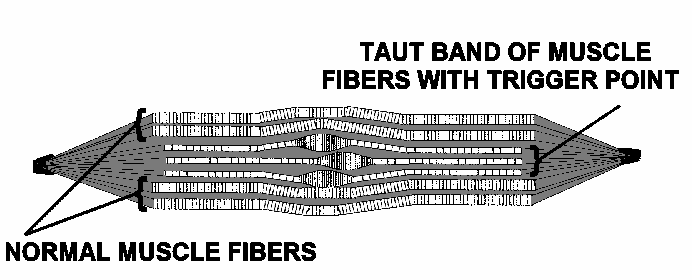
Trigger Points: Local Effects
|
The muscle fibers at the location of the active trigger point are contracted
and shortened. These sections of muscle fiber within the trigger point pull the rest of the
muscle fibers taut. Thus the muscle has a ropey band in it which is unable to
fully relax. This has three effects:-
|
|

|
-
Mechanical Weakness: Because the trigger point affected part of a muscle
fiber is contracted and shortened, and the rest of the affected muscle fiber is
lengthened, the contractile units or the muscle fiber (the sarcomeres) are either
too long or too short to achieve maximal force (sarcomeres are strongest at their
mid position). This explains the mechanical weakness of the trigger point affected muscle.
-
Reduced Stamina: Because the trigger point affected parts of a muscle are
continually active these sections of the muscle continually deplete their energy
stores, and therefore tire easily. Also, because the trigger point area in a
muscle is constantly squeezing and never relaxing, the supply of blood and oxygen
is affected, and the trigger point area is forced to rely upon lactic acid production
in order to continue to burn fuel and remain metabolically active. Lactic acid
build up inhibits muscle contractility. This explains why trigger point affected
muscles have reduced stamina. It also explains why a trigger point afflicted
athlete has a high resting blood lactic acid level.
-
Quick to damage, slow to heal: Because the trigger point affected muscle
is shorter and slower to lengthen than its neighbors, it takes more than its
healthy share of mechanical loading, and is therefore more prone to damage. Also,
because the trigger point affected muscle can never take a rest, it is unable to
relax and rebuild itself.
Summary of Local Effects, and a Clinical Implication:
We now have the picture of a trigger point affected muscle that is painful,
shortened, tires easily and is slow or unable to respond to a program of
stretching and strengthening. (Note: if you have severe and persistent trigger points, your first
priority it to down-regulate the trigger points: Only then will your affected
muscles respond to any physiotherapist prescribed exercises).

Return to top...
Biology of trigger points: local effects
© Bruce Thomson, EasyVigour Project

|
|
You can do a lot about Trigger Points!
(book reviews,click here):-
Triggerpoints & Trigger Point Book Reviews
|
|